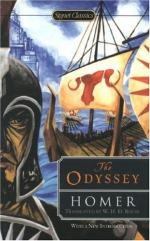FOOTNOTES
{1} Black races are evidently known to the writer as stretching all across Africa, one half looking West on to the Atlantic, and the other East on to the Indian Ocean.
{2} The original use of the footstool was probably less to rest the feet than to keep them (especially when bare) from a floor which was often wet and dirty.
{3} The [Greek] or seat, is occasionally called “high,” as being higher than the [Greek] or low footstool. It was probably no higher than an ordinary chair is now, and seems to have had no back.
{4} Temesa was on the West Coast of the toe of Italy, in what is now the gulf of Sta Eufemia. It was famous in remote times for its copper mines, which, however, were worked out when Strabo wrote.
{5} i.e. “with a current in it”—see illustrations and map near the end of bks. v. and vi. respectively.
{6} Reading [Greek] for [Greek], cf. “Od.” iii. 81 where the same mistake is made, and xiii. 351 where the mountain is called Neritum, the same place being intended both here and in book xiii.
{7} It is never plausibly explained why Penelope cannot do this, and from bk. ii. it is clear that she kept on deliberately encouraging the suitors, though we are asked to believe that she was only fooling them.
{8} See note on “Od.” i. 365.
{9} Middle Argos means the Peleponnese which, however, is never so called in the “Iliad”. I presume “middle” means “middle between the two Greek-speaking countries of Asia Minor and Sicily, with South Italy”; for that parts of Sicily and also large parts, though not the whole of South Italy, were inhabited by Greek-speaking races centuries before the Dorian colonisations can hardly be doubted. The Sicians, and also the Sicels, both of them probably spoke Greek.
{10} cf. “Il.” vi. 490-495. In the “Iliad” it is “war,” not “speech,” that is a man’s matter. It argues a certain hardness, or at any rate dislike of the “Iliad” on the part of the writer of the “Odyssey,” that she should have adopted Hector’s farewell to Andromache here, as elsewhere in the poem, for a scene of such inferior pathos.
{11} [Greek] The whole open court with the covered cloister running round it was called [Greek], or [Greek], but the covered part was distinguished by being called “shady” or “shadow-giving”. It was in this part that the tables for the suitors were laid. The Fountain Court at Hampton Court may serve as an illustration (save as regards the use of arches instead of wooden supports and rafters) and the arrangement is still common in Sicily. The usual translation “shadowy” or “dusky” halls, gives a false idea of the scene.
{12} The reader will note the extreme care which the writer takes to make it clear that none of the suitors were allowed to sleep in Ulysses’ house.
{13} See Appendix; g, in plan of Ulysses’ house.




